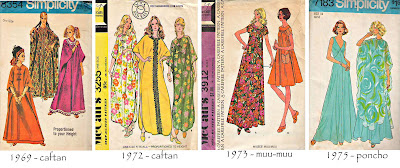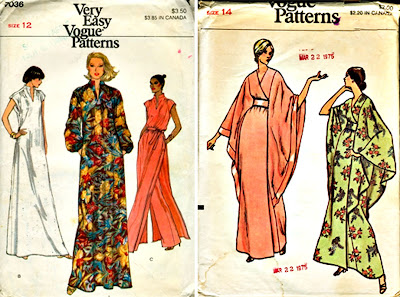I know those of you north of the 35th parallel are experiencing cooler weather verging on cold. In the Northeast you’ve brought out your tights and boots, and in the Midwest you’re preparing for the nightime lows with your down coats.
Here in Phoenix we still have the A/C blasting much of the time and I would honestly pay someone to cool this city down. I admit that we did finally get out of the 100s this week, and last night we had a wonderful cool breeze. Today the temperature may not even top 80, for the first time in about seven months. Still, I've been too dang hot for too long, and I’m just not in the mood for fall clothes just yet.
Instead, I’ve reignited my caftan obsession. Maybe it was my penguin pajama fabric that made me think of long robes, or maybe it's because when I grow up I want to be Anya on Project Runway with her long, breezy, elegant silk dresses. I love caftans, muu-muus, and any long, full, gracefully flowing robe-like garment. They put me in mind of ancient goddesses and 1960s party hostesses at the same time.
I wanted to find out about the history of these graceful garments, but was disappointed by my two fashion history books. A Survey of Historic Costume goes into some detail about the garments worn in ancient civilizations, but refers to all these styles as “tunic” except for a few references to words we no longer use such as chiton, peplos, and calasiris. African, Indian, and Asian clothing are all but ignored. In The Chronicle of Western Fashion, the same omission occurs but is at least explained by the title. So I was off to the infinite, unreliable mass of ever-changing information that is the Internet.
The caftan originally comes from the Middle East. We in the US tend to think of everyone in Arab countries as wearing robes, but there are many, many different types of robe-like garments with different purposes, and they vary by country. There are different forms of caftan or kaftan worn in Turkey and Morocco, for example, and other styles are popular in some areas of Southeast Asia.
The burnoose is actually a hooded cloak, not a closed garment like the caftan. It originated in the Arab countries as well.
The Indian kurta is similar to the caftan in that it is very long, loose, and collarless.
Also from India is the salwar kameez, in which the salwar is the pants and the kameez is a long shirt or knee-length tunic of silky, flowing fabric in a slightly more fitted style than the caftan.
The dashiki is a long tunic which originated in Africa as a sleeveless shirt for men. When it reached the US fashion scene in the 1960s it morphed into the rectangular pullover-style shirt with sleeves. If made in an ethnic print or decorated with heavy embroidered trim, it is still recognized as an “African” garment.
The muu-muu is a Hawaiian dress, originally devised by missionaries to get the lovely ladies to cover themselves up. Without getting into a big discussion of the impact of colonialism on an entire race of people and their body image I will just say that the garment is beautiful and comfortable. It is a very full dress which floats loose around the body. The standard construction is a square or round yoke or band neckline with the entire dress and sleeves gathered into it.
It’s possible that my interest in this apparel style is not coincidental: each of these originated in a hot or humid climate, and I myself am in a hot and sometimes humid climate. I would love to wear a caftan every day!
Of course I would like to wear the very elegant ones, in silk, or bejeweled velvet, or lightweight rayon batik. Sadly, these are not well suited to my messy lifestyle. So when I decide to make up some of these lovely robes, it will probably be in an inexpensive cotton gauze or a rayon poly blend.
I have a few caftan-type patterns which I’ve never tried. I enjoy looking at them, because the pictures themselves are evocative: cool elegance, psychedelic parties, ethnic history, or simply comfort.
Here in Phoenix we still have the A/C blasting much of the time and I would honestly pay someone to cool this city down. I admit that we did finally get out of the 100s this week, and last night we had a wonderful cool breeze. Today the temperature may not even top 80, for the first time in about seven months. Still, I've been too dang hot for too long, and I’m just not in the mood for fall clothes just yet.
Instead, I’ve reignited my caftan obsession. Maybe it was my penguin pajama fabric that made me think of long robes, or maybe it's because when I grow up I want to be Anya on Project Runway with her long, breezy, elegant silk dresses. I love caftans, muu-muus, and any long, full, gracefully flowing robe-like garment. They put me in mind of ancient goddesses and 1960s party hostesses at the same time.
I wanted to find out about the history of these graceful garments, but was disappointed by my two fashion history books. A Survey of Historic Costume goes into some detail about the garments worn in ancient civilizations, but refers to all these styles as “tunic” except for a few references to words we no longer use such as chiton, peplos, and calasiris. African, Indian, and Asian clothing are all but ignored. In The Chronicle of Western Fashion, the same omission occurs but is at least explained by the title. So I was off to the infinite, unreliable mass of ever-changing information that is the Internet.
The caftan originally comes from the Middle East. We in the US tend to think of everyone in Arab countries as wearing robes, but there are many, many different types of robe-like garments with different purposes, and they vary by country. There are different forms of caftan or kaftan worn in Turkey and Morocco, for example, and other styles are popular in some areas of Southeast Asia.
The burnoose is actually a hooded cloak, not a closed garment like the caftan. It originated in the Arab countries as well.
The Indian kurta is similar to the caftan in that it is very long, loose, and collarless.
Also from India is the salwar kameez, in which the salwar is the pants and the kameez is a long shirt or knee-length tunic of silky, flowing fabric in a slightly more fitted style than the caftan.
The dashiki is a long tunic which originated in Africa as a sleeveless shirt for men. When it reached the US fashion scene in the 1960s it morphed into the rectangular pullover-style shirt with sleeves. If made in an ethnic print or decorated with heavy embroidered trim, it is still recognized as an “African” garment.
The muu-muu is a Hawaiian dress, originally devised by missionaries to get the lovely ladies to cover themselves up. Without getting into a big discussion of the impact of colonialism on an entire race of people and their body image I will just say that the garment is beautiful and comfortable. It is a very full dress which floats loose around the body. The standard construction is a square or round yoke or band neckline with the entire dress and sleeves gathered into it.
It’s possible that my interest in this apparel style is not coincidental: each of these originated in a hot or humid climate, and I myself am in a hot and sometimes humid climate. I would love to wear a caftan every day!
Of course I would like to wear the very elegant ones, in silk, or bejeweled velvet, or lightweight rayon batik. Sadly, these are not well suited to my messy lifestyle. So when I decide to make up some of these lovely robes, it will probably be in an inexpensive cotton gauze or a rayon poly blend.
I have a few caftan-type patterns which I’ve never tried. I enjoy looking at them, because the pictures themselves are evocative: cool elegance, psychedelic parties, ethnic history, or simply comfort.
 My collection of 70s-era caftan patterns.
My collection of 70s-era caftan patterns.Here are some I don’t own (yet). (All images are from the vintage patterns wiki) So elegant!

Note on S 6060 - I don’t really love the pattern but how about that blond guy with the 70s mustache and glasses? Cult leader?
And two beautiful Vogue styles – As usual, Vogue blows everyone else out of the water with elegant details.

Folkwear has some beautiful designs, like the Syrian Dress # 105 and the Gaza Dress, #101.  Source
Source
And there are several Hawaiian pattern companies that will have you dreaming of palm trees and hibiscus: 
Basically just WOW. source
So, will I actually make some of these beautiful caftans? I hope to, in the near future!
How do you feel about caftans and muu-muus?
Katrina
I LOVE caftans! They are perfect in the summer; all floaty and cool. But I also like them in the cooler weather, and I recently aquired a NOS velour one from the 1960's that I am anxious to wear. And now (thank you very much!) I am pouring over patterns on Etsy. I have some vintage fabric in my stash that would be perfect!
ReplyDeletexo, Anita
Velour sounds perfect. I'm even thinking about using some bamboo jersey that I have for a caftan. Soft!
ReplyDeleteWe are kindred spirits! I share your love of muumuus and caftans, and have made a few and intend to make more. It is a while since you have posted on this thread so I hope you are well and thriving - and sewing, of course.
ReplyDelete